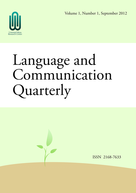


Volume 10 Issues 1-4 (2021-12-31)
Volume 9 Issues 1-4 (2020-12-31)
Volume 8 Issues 1&2 (2019-06-30)
Volume 7 Issues 3&4 (2018-12-31)
Volume 7 Issues 1&2 (2018-06-30)
Volume 6 Issues 3&4 (2017-12-31)
Volume 6 Issues 1&2 (2017-06-30)
Volume 5 Issues 3&4 (2016-12-31)
Volume 5 Issues 1&2 (2016-06-30)
Volume 4 Issues 3&4 (2015-12-31)
This study examines the phenomenon of code-switching in an Islamic religious classroom in Singapore. It includes actual instances of conversation and examines factors associated with code choice. What does mixed code look like in the religious class? How and why are teachers (and students) code switching? These findings are then linked to the implications of religious code switching in the wider context of language shift in the Malay community of Singapore, bearing in mind that religion is often the most resistant domain for language change or language shift. The data is taken from part of a three-year ethnographic (2009-2012), discourse-analytic research project which includes videotaped classroom observations, ethnographic interviews, and participant observation at home and school.
There once was a time when banker evoked the image of an elegant and authoritative businessperson and was not viewed as an unpleasant, dirty, word. Banking was a matter of confidence, and until recently, it would have been unthinkable to hear of a certain zombie bank, a failing financial institution benefiting from governmental bailout programs, not to mention casino banks that dramatically failed to manage credit risk successfully. Crunch referred to the act of eating noisily and was only seldom involved in credit issues. Finally toxic had to do with extremely harmful substances and did not collocate with financial assets. What is happening to our language? And most importantly, how do financial crises really impact on our everyday language? In this paper, I argue that in this time of austerity, business language is being enriched by a new linguistic phenomenon: crisis language. As a consequence, financial crises emerge as real discursive events described, discussed and disseminated via language. With this in mind, the aim of this paper is to analyze the language of “The Economist” used to report on the worst financial crises in modern capitalism: the 1929 Great Depression, the 2000 Dot.Com Bubble and the 2008 Subprime Mortgage Bubble. To do so, a wide range of articles were selected over a time reference of six months, covering the period that immediately followed the key-events of each crisis: the Wall Street Crash of October 24, 1929; the Nasdaq Crash of April 14, 2000 and the Lehman Brothers Default of September 17, 2008. By exploring the concept of collocation in terms of meaning, with reference to some words peculiar to the field of banking and finance, we will become aware that the elapsing of time heavily impacted the discursive representation of financial crises. Besides that, the diachronic study surprisingly offered an illuminating contrast as to the way the theme of responsibility was discursively approached. Finally, an almost contradictory if not paradoxical conclusion will be unveiled: in time of crisis, crisis language seemed to be the only thing untouched by the crisis, and unexpectedly showed vitality presently unexplored in other social, economic and financial domains.
Having learned lessons from Hurricane Katrina (and even Irene) government agencies were proactive in using the media and converged forms of communication to prepare and warn residents as super storm Sandy approached the east coast in 2012. While the storm costs are estimated in the billions, this storm will be remembered in the field of public relations and crisis communications as one in which effective communication played a significant role in saving lives and improving preparation efforts. In constructing this analysis of crisis communication, the author provides a critical analysis of crisis communication strategies and capabilities through a Situational Crisis Communication Theory (SCCT) perspective.
In the present paper, the authors consider the quality characteristics of the newscasts of local scope television stations in U.S.A., not only from within, but also compared to the corresponding characteristics of the newscasts in television stations addressing a wider scope/market. This research provided detailed content analysis of 30 newscasts of local TV stations. The samples of 30 newscasts were collected by a group of doctoral students from June 7th to June 17th, 2010. During the 11 days, each student recorded two newscasts at 11 pm from their local TV stations and carefully coded the content of newscasts for further analysis. Altogether 30 local newscasts (18 from large markets and 12 from small markets) were coded based on the category of segment type, scope and topic of the news content. Three TV networks: ABC, CBS and NBC across five large TV stations and four small TV stations were covered in the research. In the U.S. media system, TV news coverage has always played an important part in serving public interests. The latest argument against TV news coverage was that there were too many non-news contents such as infomercials formidably covered in the TV newscasts. This particular content analysis aimed at investigating whether local TV news really covers more of local news or more of other news content.